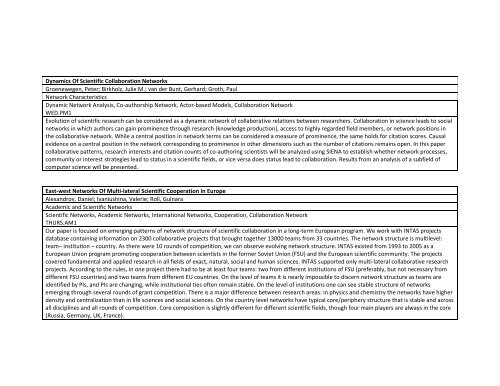Sunbelt XXXI International Network for Social Network ... - INSNA
Sunbelt XXXI International Network for Social Network ... - INSNA
Sunbelt XXXI International Network for Social Network ... - INSNA
Create successful ePaper yourself
Turn your PDF publications into a flip-book with our unique Google optimized e-Paper software.
Dynamics Of Scientific Collaboration <strong>Network</strong>sGroenewegen, Peter; Birkholz, Julie M.; van der Bunt, Gerhard; Groth, Paul<strong>Network</strong> CharacteristicsDynamic <strong>Network</strong> Analysis, Co‐authorship <strong>Network</strong>, Actor‐based Models, Collaboration <strong>Network</strong>WED.PM1Evolution of scientific research can be considered as a dynamic network of collaborative relations between researchers. Collaboration in science leads to socialnetworks in which authors can gain prominence through research (knowledge production), access to highly regarded field members, or network positions inthe collaborative network. While a central position in network terms can be considered a measure of prominence, the same holds <strong>for</strong> citation scores. Causalevidence on a central position in the network corresponding to prominence in other dimensions such as the number of citations remains open. In this papercollaborative patterns, research interests and citation counts of co‐authoring scientists will be analyzed using SIENA to establish whether network processes,community or interest strategies lead to status in a scientific fields, or vice versa does status lead to collaboration. Results from an analysis of a subfield ofcomputer science will be presented.East‐west <strong>Network</strong>s Of Multi‐lateral Scientific Cooperation In EuropeAlexandrov, Daniel; Ivaniushina, Valerie; Roll, GulnaraAcademic and Scientific <strong>Network</strong>sScientific <strong>Network</strong>s, Academic <strong>Network</strong>s, <strong>International</strong> <strong>Network</strong>s, Cooperation, Collaboration <strong>Network</strong>THURS.AM1Our paper is focused on emerging patterns of network structure of scientific collaboration in a long‐term European program. We work with INTAS projectsdatabase containing in<strong>for</strong>mation on 2300 collaborative projects that brought together 13000 teams from 33 countries. The network structure is multilevel:team– institution – country. As there were 10 rounds of competition, we can observe evolving network structure. INTAS existed from 1993 to 2005 as aEuropean Union program promoting cooperation between scientists in the <strong>for</strong>mer Soviet Union (FSU) and the European scientific community. The projectscovered fundamental and applied research in all fields of exact, natural, social and human sciences. INTAS supported only multi‐lateral collaborative researchprojects. According to the rules, in one project there had to be at least four teams: two from different institutions of FSU (preferably, but not necessary fromdifferent FSU countries) and two teams from different EU countries. On the level of teams it is nearly impossible to discern network structure as teams areidentified by PIs, and PIs are changing, while institutional ties often remain stable. On the level of institutions one can see stable structure of networksemerging through several rounds of grant competition. There is a major difference between research areas: in physics and chemistry the networks have higherdensity and centralization than in life sciences and social sciences. On the country level networks have typical core/periphery structure that is stable and acrossall disciplines and all rounds of competition. Core composition is slightly different <strong>for</strong> different scientific fields, though four main players are always in the core(Russia, Germany, UK, France).
















